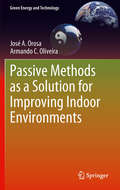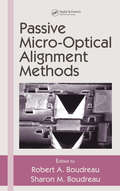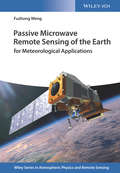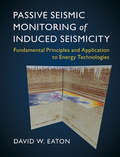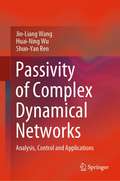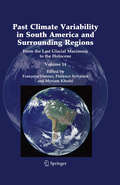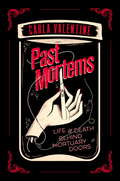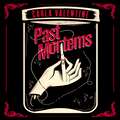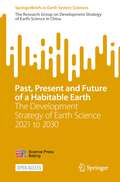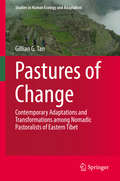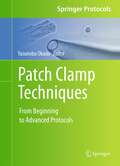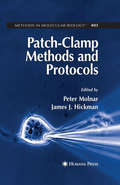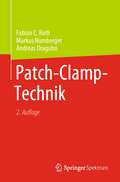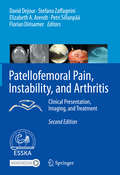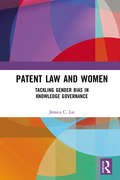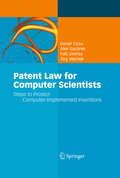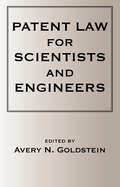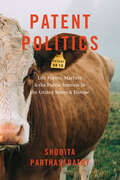- Table View
- List View
Passive Methods as a Solution for Improving Indoor Environments
by José A. Orosa Armando C. OliveiraThere are many aspects to consider when evaluating or improving an indoor environment; thermal comfort, energy saving, preservation of materials, hygiene and health are all key aspects which can be improved by passive methods of environmental control. Passive Methods as a Solution for Improving Indoor Environments endeavours to fill the lack of analysis in this area by using over ten years of research to illustrate the effects of methods such as thermal inertia and permeable coverings; for example, the use of permeable coverings is a well known passive method, but its effects and ways to improve indoor environments have been rarely analyzed. Passive Methods as a Solution for Improving Indoor Environments includes both software simulations and laboratory and field studies. Through these, the main parameters that characterize the behavior of internal coverings are defined. Furthermore, a new procedure is explained in depth which can be used to identify the real expected effects of permeable coverings such as energy conservation and local thermal comfort as well as their working periods in controlling indoor environments. This theoretical base is built on by considering future research work including patents and construction indications which will improve indoor environmental conditions with evidence from real data. This makes Passive Methods as a Solution for Improving Indoor Environments an ideal resource for specialists and researchers focusing on indoor air quality, thermal comfort, and energy saving or with a general interest in controlling indoor environments with passive methods.
Passive Micro-Optical Alignment Methods
by Robert A. Boudreau Sharon M. BoudreauThe most expensive phase in the manufacture of micro-optical components and fiber optics is also one of the most performance-critical: optical alignment of the components. The increasing degree of miniaturization makes this an especially challenging task. Active alignment methods result in higher costs and awkward processes, and for some applications, they simply are not possible. Passive Micro-Optical Alignment Methods introduces the passive alignment methods that are currently available and illustrates them with many examples, references, and critiques.The first book dedicated to passive alignment, it begins with an overview of the current activities, requirements, and general results of passive optical alignments, followed by three sections of in-depth analysis. The first of these discusses mechanical passive alignment, highlighting silicon waferboard, solder, and "Jitney" technologies as well as application of mechanical alignment to 3D free-space interconnects. The next section describes the various visual alignment techniques applied to Planar Lightwave Circuits (PLCs) and low-cost plastic and surface mount packaging. The final section details various utilities that aid passive alignment and their resulting tradeoffs and demonstrates Monte Carlo analysis to evaluate the potential of a given method.Passive Micro-Optical Alignment Methods provides the tools necessary to meet the challenge of precision and low-cost alignment for applications that require micron or sub-micron tolerance.
Passive Microwave Remote Sensing of the Earth: for Meteorological Applications
by Fuzhong WengThis book covers the fundamentals of satellite microwave instrument calibration, remote sensing sciences and algorithms, as well as the applications of the satellite microwave observations in weather and climate research.
Passive Optical Resonators for Next-Generation Attosecond Metrology (SpringerBriefs in Physics)
by Ioachim PupezaThis book introduces readers to the development of a new generation of high pulse-repetition frequency instruments for multi-dimensional attosecond-resolution photoelectron spectroscopy (attosecond PES). It investigates the power scaling of femtosecond enhancement cavities for efficient intracavity high-harmonics generation (HHG). Further, it derives and verifies advanced resonator designs that feature large illuminated spots on all mirrors, which mitigate both intensity- and thermally-induced enhancement limitations.The dynamics of a high-finesse, passive resonator in the presence of a highly nonlinear optical process such as HHG are quantitatively investigated, both theoretically and experimentally. These investigations are instrumental in achieving the holistic optimization of the XUV source reported on here, which for the first time reached intracavity HHG conversion efficiencies comparable to those achieved in single-pass setups with a similar gas target.Coupling out the XUV beam from the enhancement cavity by purely geometric means, employing both the fundamental and higher-order transverse Gaussian modes, is studied. This offers the advantages of robustness, low distortion to the participating pulses, and photon-energy scalability. Last but not least, the author provides a range of proof-of-principle attosecond angle-resolved PES experiments.The book gives an outlook on the possible future development of cavity-enhanced HHG and an extensive discussion on the generation of isolated XUV attosecond pulses via intracavity wavefront rotation.
Passive Seismic Monitoring of Induced Seismicity: Fundamental Principles And Application To Energy Technologies
by David W. EatonThe past few decades have witnessed remarkable growth in the application of passive seismic monitoring to address a range of problems in geoscience and engineering, from large-scale tectonic studies to environmental investigations. Passive seismic methods are increasingly being used for surveillance of massive, multi-stage hydraulic fracturing and development of enhanced geothermal systems. The theoretical framework and techniques used in this emerging area draw on various established fields, such as earthquake seismology, exploration geophysics and rock mechanics. <P><P>Based on university and industry courses developed by the author, this book reviews all the relevant research and technology to provide an introduction to the principles and applications of passive seismic monitoring. It integrates up-to-date case studies and interactive online exercises, making it a comprehensive and accessible resource for advanced students and researchers in geophysics and engineering, as well as industry practitioners.<P> Presents real field data demonstrating how passive seismic monitoring works in practice.<P> Interactive online problems are provided, enabling readers to test their knowledge and understanding.<P> Provides an interdisciplinary overview of the topic combining fundamental and applied elements.
Passivity of Complex Dynamical Networks: Analysis, Control and Applications
by Jin-Liang Wang Huai-Ning Wu Shun-Yan RenThis book intends to introduce some recent results on passivity of complex dynamical networks with single weight and multiple weights. The book collects novel research ideas and some definitions in complex dynamical networks, such as passivity, output strict passivity, input strict passivity, finite-time passivity, and multiple weights. Furthermore, the research results previously published in many flagship journals are methodically edited and presented in a unified form. The book is likely to be of interest to university researchers and graduate students in Engineering and Mathematics who wish to study the passivity of complex dynamical networks.
Past Climate Variability in South America and Surrounding Regions
by Florence Sylvestre Francoise Vimeux Myriam KhodriThis book groups together overviews and original research papers dealing with South American climate variability from the Last Glacial Maximum to the Holocene. The contributions deal with tropical, temperate and high latitudes climate variability in South America and in surrounding regions (including Pacific and Atlantic Oceans and Antarctica). It offers results obtained from both natural climate archives and recent simulations from coupled climate models. The objective is to propose a state of the art about our knowledge of past climate variability in South America. Specifically, this book aims at presenting the whole available observations and at discussing climate mechanisms, specifically the low to high latitude teleconnections on that continent which spreads out from the equator to Patagonia. It is written by an expert group of climate change scientists, and presents an insight into dynamics of the past and provides climate modellers with work of reference for data-model comparison. The book is an advanced but very readable text essential for all students and scientists interested in global environmental change.
Past Environments of Mexico: Unveiling the Past Environments of a Megadiverse Country Through its Fossil Record (Springer Geology)
by Rosalía Guerrero-Arenas Eduardo Jiménez-HidalgoMexico is a biodiverse country. The dynamics of environments from Mexico played a crucial role in the history of North American biota. This book analyzes the paleoenvironmental conditions using several biological groups and various methods. This book also demonstrates how this information is specifically used to elucidate Mexico‘s past environments and habitats (terrestrial, freshwater, and marine). This book fills an existing editorial gap since much of the information is dispersed in several bibliographic sources. The authors are active paleontologists in diverse Mexican universities and research centers. Their research activities contribute to the knowledge of the Mexican biota through geologic time.
Past Mortems: Life and death behind mortuary doors
by Carla ValentineA day in the life of Carla Valentine - curator, pathology technician and 'death professional' - is not your average day. She spent ten years training and working as an Anatomical Pathology Technologist: where the mortuary slab was her desk, and that day's corpses her task list.Past Mortems tells Carla's stories of those years, as well as investigating the body alongside our attitudes towards death - shedding light on what the living can learn from dead and the toll the work can take on the living souls who carry it out. Fascinating and insightful, Past Mortems reveals the truth about what happens when the mortuary doors swing shut or the lid of the coffin closes . . .
Past Mortems: Life and death behind mortuary doors
by Carla ValentineA day in the life of Carla Valentine - curator, pathology technician and 'death professional' - is not your average day. She spent ten years training and working as an Anatomical Pathology Technologist: where the mortuary slab was her desk, and that day's corpses her task list.Past Mortems tells Carla's stories of those years, as well as investigating the body alongside our attitudes towards death - shedding light on what the living can learn from dead and the toll the work can take on the living souls who carry it out. Fascinating and insightful, Past Mortems reveals the truth about what happens when the mortuary doors swing shut or the lid of the coffin closes . . .
Past To Present: Ideas That Changed Our World
by Stuart Hirschberg Terry HirschbergComprehensive and accessible, Past to Present encapsulates for readers essential readings from the fields of humanities, social science, and science in a single book- putting a "human face" on the great ideas that have changed our world. The book is divided into seven thematic parts that trace the history of important ideas from their roots to their current incarnations. Each of the 73 readings includes discussions that focus on the history of the idea, the writer's rhetorical strategies, and the context in which the piece was written. For anyone who is interested in exploring the evolutions of the great ideas of our world.
Past, Present and Future of a Habitable Earth: The Development Strategy of Earth Science 2021 to 2030 (SpringerBriefs in Earth System Sciences)
by Res. Group Dev Strategy of Earth ScienceThis perspective of this book views Earth's various layers as a whole system, and tries to understand how to achieve harmony and sustainable development between human society and nature, with the theme of " habitability of the Earth." This book is one effort at providing an overview of some of the recent exciting advances Chinese geoscientists have made. It is the concerted team effort of a group of researchers from diverse backgrounds to generalize their vision for Earth science in the next 10 years. The book is intended for scholars, administrators of the Science and Technology policy department, and science research funding agencies. This is an open access book.
Pasteur and Modern Science
by Rene DubosThis is a fresh account of the extraordinary life of Louis Pasteur, and the monumental impact he had on biochemistry, microbiology, bacteriology and immunology.
Pastures of Change: Contemporary Adaptations And Transformations Among Nomadic Pastoralists Of Eastern Tibet (Studies In Human Ecology And Adaptation Ser. #10)
by Gillian G. TanThis book offers a novel examination of socio-environmental change in a nomadic pastoralist area of the eastern Tibetan plateau. Drawing on long-term fieldwork that underscores an ethnography of local nomadic pastoralists, international development organisations, and Chinese government policies, the book argues that careful analysis and comparison of the different epistemologies and norms about "change" are vital to any critical appraisal of developments - often contested - on the grasslands of Eastern Tibet.Tibetan nomads have developed a way of life that is dependent in multiple ways on their animals and shaped by the phenomenological experience of mobility. These pastoralists have adapted to many changes in their social, political and environmental contexts over time. From the earliest historically recorded systems of segmentary lineage to the incorporation first into local fiefdoms and then into the Chinese state (of both Nationalist and Communist governments), Tibetan pastoralists have maintained their way of life, complemented by interactions with "the outside world".Rapid changes brought about by an intensification of interactions with the outside world call into question the sustained viability of a nomadic way of life, particularly as pastoralists themselves sell their herds and settle into towns. This book probes how we can more clearly understand these changes by looking specifically at one particular area of high-altitude grasslands in the Tibetan Plateau.
Patch Clamp Techniques
by Yasunobu OkadaChannels and transporters are multi-functional proteins that mediate substrate transport and signal transmission and simultaneously act as regulators for other proteins and biosensors for environmental materials. Patch clamping is an epoch-making technique that allows researchers to perform real-time measurements of electrogenic channel/transporter functions at the single/multiple molecular level. This book describes not only the conventional patch clamp techniques but also their newly developed variations or applications, such as perforated patch, slice patch, blind patch, in vivo patch, imaging patch, smart patch, and automated patch clamping. These patch clamp techniques are now essential and are extensively used across the life sciences and in related industries. With plain and practical descriptions of patch clamping and how to carry it out, especially for beginners, the book also shows how widely and exquisitely the patch clamp techniques can be applied by expert electrophysiologists. This work serves as a useful guide for young researchers and students in training and laboratory courses as well as for senior researchers who wish to extend their repertoire of techniques.
Patch-Clamp Methods and Protocols
by Peter Molnar James J. HickmanPatch Clamp Methods and Protocols surveys the typical patch clamp applications and advises scientists on identifying problems and selecting the best technique in each instance. The experiments described aid the researcher in pursuing new areas of electrophysiology and using the patch clamp technique effectively. The volume includes an extensive theoretical treatise concerning single channel kinetic analysis.
Patch-Clamp-Technik
by Fabian C. Roth Markus Numberger Andreas DraguhnDie Patch-Clamp-Technik ist heute eine der wichtigsten neurophysiologischen Arbeitsmethoden. Ihre Anwendung hat in der biomedizinischen Grundlagenforschung bedeutende Erkenntnisse über die Funktion und die Eigenschaften von Ionenkanälen erbracht, und auch aus der angewandten pharmakologischen Forschung ist sie inzwischen nicht mehr wegzudenken. Klar und praxisbezogen vermitteln die Autoren die wesentlichen Informationen, um die Methode im Labor einzuführen und erfolgreich anzuwenden. Das Buch erläutert die theoretischen Grundlagen der Messung, den detaillierten Aufbau eines Messplatzes und die praktische Durchführung typischer Messkonfigurationen. Konkrete Tipps und Tricks helfen beim „Trouble-Shooting“ und sind nicht nur für Neuanwender eine unverzichtbare Hilfe.
Patellofemoral Pain, Instability, and Arthritis
by Elizabeth A. Arendt Stefano Zaffagnini David DejourDespite numerous studies, a lack of consensus still exists over many aspects of patellofemoral pain, instability, and arthritis. This book adopts an evidence-based approach to assess each of these topics in depth. The book reviews general features of clinical examination and global evaluation techniques including the use of different imaging methods, e.g. x-rays, CT, MRI, stress x-rays, and bone scan. Various conservative and surgical treatment approaches for each of the three presentations - pain, instability, and arthritis - are then explained and assessed. Postoperative management and options in the event of failed surgery are also evaluated. Throughout, careful attention is paid to the literature in an attempt to establish the level of evidence for the efficacy of each imaging and treatment method. It is hoped that this book will serve as an informative guide for the practitioner when confronted with disorders of the patellofemoral joint.
Patellofemoral Pain, Instability, and Arthritis: Clinical Presentation, Imaging, and Treatment
by Elizabeth A. Arendt Stefano Zaffagnini David Dejour Petri Sillanpää Florian DirisamerThis excellently illustrated book adopts an evidence-based approach to evaluate the efficacy of different techniques for the imaging and treatment of patellofemoral pain, instability, and arthritis. The aim is to equip practitioners with an informative guide that will help them to manage disorders of the patellofemoral joint by casting light on the many issues on which a consensus has been lacking. The opening chapters supply essential background information and explain the role of various imaging modalities, including radiography, CT, MRI, and bone scan. The various conservative and surgical treatment approaches for each of the three presentations – pain, instability, and arthritis – are then described and assessed in depth, with precise guidance on indications and technique. Postoperative management and options in the event of failed surgery are also evaluated. Throughout, careful attention is paid to the literature in an attempt to establish the level of evidence for each imaging and treatment method. The new edition has been thoroughly updated, with inclusion of additional chapters, in order to present the latest knowledge on biomechanics, diagnosis, surgical techniques, and rehabilitation.
Patent Engineering: A Guide to Building a Valuable Patent Portfolio and Controlling the Marketplace
by Donald S. RimaiPatents are a vital asset in the modern business world. They allow patent holders to introduce new products in to a market while deterring other market players from simply copying innovative features without making comparable investments in research and development. In years past, a few patents may have provided adequate protection. That is no longer the case. In today's world, it is critical that innovative companies protect the features of their products that give them a competitive advantage with a family or portfolio of patents that are strategically generated to protect the market position of the patent holder. A patent portfolio that deters competitors from introducing competitive products in a timely manner can be worth billions of dollars. Anything less than this is an expensive and possibly fatal distraction. This book provides a strategic framework for cost efficient engineering of patent portfolios that protect your investments in research and development and that extend the market advantages that these investments provide.
Patent Law and Women: Tackling Gender Bias in Knowledge Governance
by Jessica C. LaiThis book analyses the gendered nature of patent law and the knowledge governance system it supports. The vast majority of patented inventions are attributed to male inventors. While this has resulted in arguments that there are not enough women working in science, technology, engineering and mathematics, this book maintains that the issue lies with the very nature of patent law and how it governs knowledge. The reason why fewer women patent than men is that patent law and the knowledge governance system it supports are gendered. This book deconstructs patent law to reveal the multiple gendered binaries it embodies, and how these in turn reflect gendered understandings of what constitutes science and an invention, and a scientist and an inventor. Revealing the inherent biases of the patent system, as well as its reliance on an idea of the public domain, the book argues that an egalitarian knowledge governance system must go beyond socialised binaries to better govern knowledge creation, dissemination and maintenance. This book will appeal to scholars and policymakers in the field of patent law, as well as those in law and other disciplines with interests in law, gender and technology.
Patent Law for Computer Scientists
by Jörg Machek Daniel Closa Alex Gardiner Falk GiemsaPatent laws are different in many countries, and inventors are sometimes at a loss to understand which basic requirements should be satisfied if an invention is to be granted a patent. This is particularly true for inventions implemented on a computer. While roughly a third of all applications (and granted patents) relate, in one way or another, to a computer, applications where the innovation mainly resides in software or in a business method are treated differently by the major patent offices in the US (USPTO), Japan (JPO), and Europe (EPO). The authors start with a thorough introduction into patent laws and practices, as well as in related intellectual property rights, which also explains the procedures at the USPTO, JPO and EPO and, in particular, the peculiarities in the treatment of applications centering on software or computers. Based on this theoretical description, next they present in a very structured way a huge set of case studies from different areas like business methods, databases, graphical user interfaces, digital rights management, and many more. Each set starts with a rather short description and claim of the "invention", then explains the arguments a legal examiner will probably have, and eventually refines the description step by step, until all the reservations are resolved. All of these case studies are based on real-world examples, and will thus give an inexperienced developer an idea about the required level of detail and description he will have to provide. Together, Closa, Gardiner, Giemsa and Machek have more than 70 years experience in the patent business. With their academic background in physics, electronic engineering, and computer science, they know about both the legal and the subject-based subtleties of computer-based inventions. With this book, they provide a guide to a patent examiner's way of thinking in a clear and systematic manner, helping to prepare the first steps towards a successful patent application.
Patent Laws for Scientists and Engineers
by Avery N. GoldsteinAlthough many texts attempt to explain intellectual property law to scientists and engineers, they are ineffective because they fail to present the subject within the proper scope; they are either too expansive or too detailed for the needs of researchers and inventors. Instead of giving a mile-high view of all types of intellectual property or, at
Patent Politics: Life Forms, Markets, and the Public Interest in the United States and Europe
by Shobita ParthasarathyOver the past thirty years, the world’s patent systems have experienced pressure from civil society like never before. From farmers to patient advocates, new voices are arguing that patents impact public health, economic inequality, morality—and democracy. These challenges, to domains that we usually consider technical and legal, may seem surprising. But in Patent Politics, Shobita Parthasarathy argues that patent systems have always been deeply political and social. To demonstrate this, Parthasarathy takes readers through a particularly fierce and prolonged set of controversies over patents on life forms linked to important advances in biology and agriculture and potentially life-saving medicines. Comparing battles over patents on animals, human embryonic stem cells, human genes, and plants in the United States and Europe, she shows how political culture, ideology, and history shape patent system politics. Clashes over whose voices and which values matter in the patent system, as well as what counts as knowledge and whose expertise is important, look quite different in these two places. And through these debates, the United States and Europe are developing very different approaches to patent and innovation governance. Not just the first comprehensive look at the controversies swirling around biotechnology patents, Patent Politics is also the first in-depth analysis of the political underpinnings and implications of modern patent systems, and provides a timely analysis of how we can reform these systems around the world to maximize the public interest.
Patente in der Praxis: Einführung für Ingenieure und Naturwissenschaftler im ersten Umgang mit technischen Schutzrechten
by Stefan BaslerPatente und Gebrauchsmuster sind unverzichtbare Instrumente in der täglichen Arbeit von Ingenieuren und Naturwissenschaftlern. Sie spielen eine wichtige Rolle beim Schutz technischer Innovationen und veröffentlichen technisches Wissen.Dieses Buch gibt einen Einblick in die spannende Welt der technischen Schutzrechte. Nach einer kurzen Einführung erklärt es dem Leser die Struktur von Patentschriften. Dies befähigt ihn diese zielgerichtet zu lesen und in kurzer Zeit zu bewerten. Weiterführende Themen richten sich an Personen die zusätzliches Wissen im Patentwesen erwerben möchten, um z.B. in einer Fachabteilung oder einem Unternehmen ohne Patentabteilung weiterführende Aufgaben zu übernehmen oder um schutzrechtsbezogene Entscheidungen treffen zu können.
